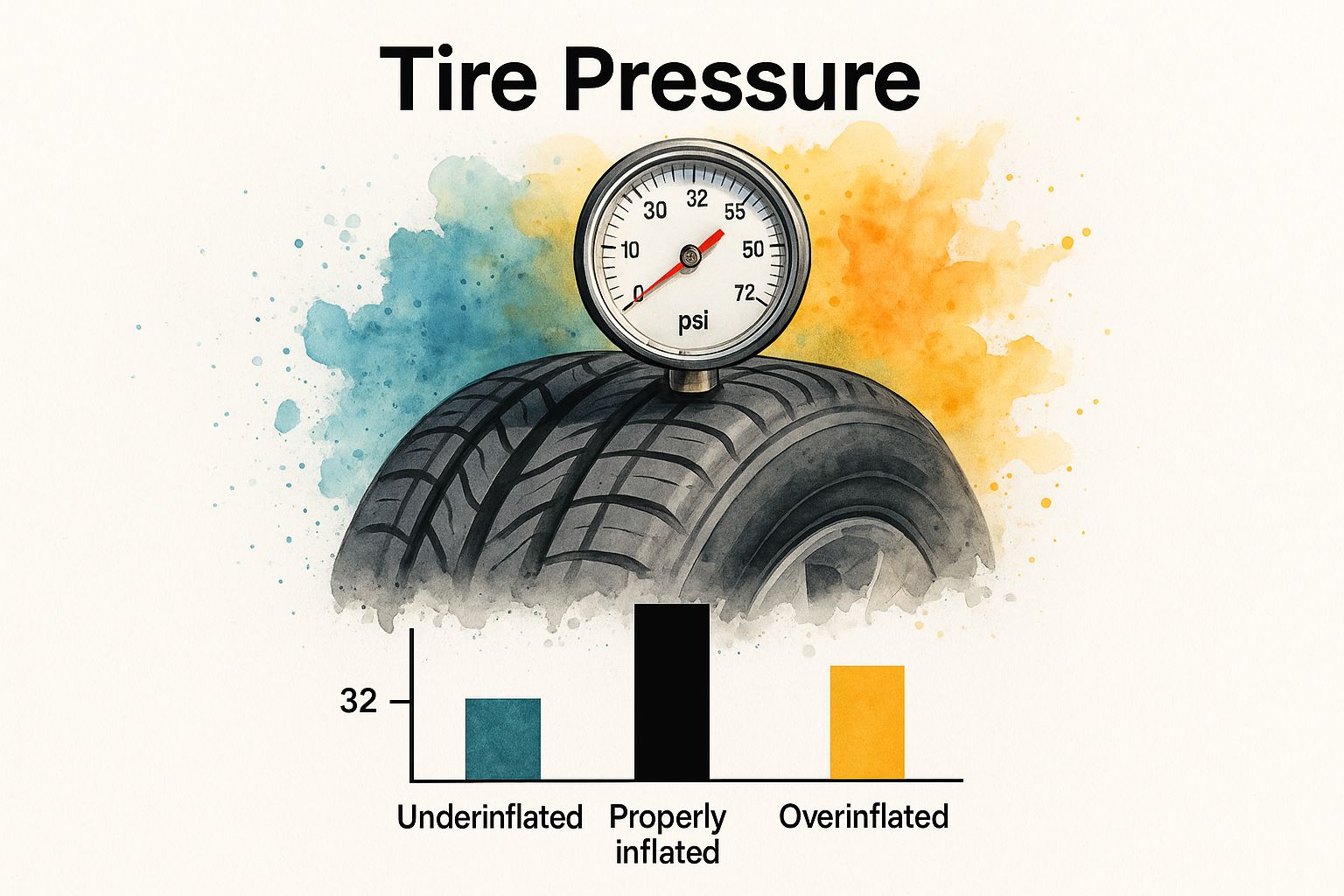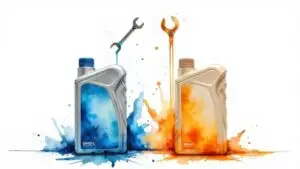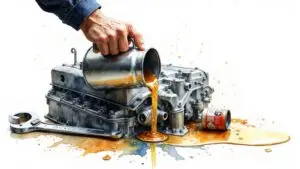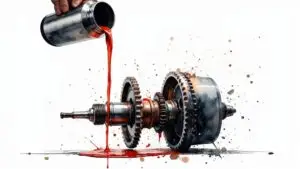Why Your Car's Lifespan Matters More Than Ever

Extending the lifespan of your car is now more critical than ever. With the current economic climate and rising costs, maximizing your vehicle's life has become a significant financial consideration. For helpful tips and advice on car maintenance, check out these car maintenance tips. Getting the most out of your current car is no longer just a good habit; it's a smart financial move.
The Economics of Longevity
Modern cars, with proper care, are designed to last much longer than their predecessors. Each additional year you keep your car represents significant savings. This is largely due to avoiding the immediate depreciation new cars face.
A new car loses a substantial portion of its value the moment it's driven off the lot. By holding onto your car for longer, you avoid this initial hit and save potentially thousands of dollars. This makes maximizing your car's lifespan a key element of long-term financial planning.
The Global Trend of Longer Vehicle Lifespans
The trend of keeping cars longer is a global phenomenon. Worldwide, the average age of vehicles is steadily increasing, driving up the demand for maintenance and parts. The average age of cars in Germany reached 10 years in 2023. Across the EU, the average age of cars climbed from 10.6 years in 2016 to 12.3 years in 2022.
In the US, the average age of cars and light trucks hit a record 12.6 years in 2024. Factors such as increasing new car prices and uncertainty surrounding electric vehicles contribute to this trend. This makes proper maintenance and timely repairs more important than ever. An increasing number of cars fall into the "prime range" for aftermarket services (between 6-14 years old). In 2024, over 110 million cars in the US, representing almost 38% of the total fleet, were in this prime range, and this number is projected to grow. Maintaining your car well significantly extends its usable life and economic value. You can find more detailed statistics on this trend here.
To illustrate this trend further, let's examine a comparison of average vehicle lifespans across different regions:
Average Vehicle Lifespan by Region
Comparison of how long cars typically last in different regions and how this has changed over time.
| Region | Average Age (2016) | Average Age (2022-2024) | Percentage Increase |
|---|---|---|---|
| EU | 10.6 years | 12.3 years | 16% |
| US | N/A | 12.6 years | N/A |
| Germany | N/A | 10 years (2023) | N/A |
As this table demonstrates, vehicle lifespans are notably increasing, particularly within the EU. This reinforces the global trend of holding onto cars for longer periods.
Making Informed Decisions for Long-Term Value
This extended lifespan changes how we think about car maintenance. Strategic maintenance isn’t just about keeping a car running; it’s about maximizing your investment. Investing in preventative maintenance now can prevent more expensive repairs later, increasing your vehicle's overall value over time. Understanding this allows drivers to make informed decisions that benefit both their finances and their peace of mind.
Fluid Maintenance Mastery: The Lifeblood of Longevity
Maintaining your car's longevity depends heavily on consistent fluid maintenance. These fluids are essential, working tirelessly behind the scenes. Think of your car's engine as its heart, with fluids acting as its lifeblood. Just as a healthy heart needs clean, oxygenated blood, your engine needs clean, high-quality fluids to perform optimally. Neglecting these fluids can lead to decreased performance, expensive repairs, and a significantly shorter lifespan for your vehicle. Learn more about the importance of services like oil changes and tire rotations.
The Importance of Routine Checks and Replacements
Regular checks and replacements of your car’s fluids are the cornerstone of preventative maintenance. It's not just about topping off; it's about understanding your vehicle’s specific needs and adhering to a consistent maintenance schedule. Different fluids have varying lifespans and replacement intervals. For example, engine oil typically needs changing every 3,000 to 5,000 miles for conventional oil, or 7,500 to 10,000 miles for synthetic. Brake fluid should be changed every two to three years.
This can vary based on driving habits and vehicle type, so consulting your owner's manual is always recommended.
Learning basic visual inspections can help catch potential problems early. Knowing what to look for regarding fluid color, consistency, and smell can provide valuable insights between scheduled maintenance. This proactive approach can prevent small issues from becoming major, budget-busting repairs.
To help you stay on top of your vehicle's fluid maintenance needs, we've compiled a comprehensive guide:
Fluid Maintenance Schedule Guide: Comprehensive guide to when each vehicle fluid should be checked and replaced
| Fluid Type | Check Frequency | Replacement Interval | Warning Signs | Consequences of Neglect |
|---|---|---|---|---|
| Engine Oil | Every 1,000 miles or with each gas fill-up | 3,000-5,000 miles (conventional) 7,500-10,000 miles (synthetic) | Dark or gritty oil, low oil level, burning smell | Engine damage, reduced fuel efficiency |
| Coolant | Every 1,000 miles or with each gas fill-up | Every 2-3 years or as recommended by manufacturer | Low coolant level, overheating, sweet smell | Overheating, engine damage, radiator leaks |
| Brake Fluid | Every 6 months | Every 2-3 years or as recommended by manufacturer | Spongy brake pedal, decreased braking performance | Brake failure, reduced safety |
| Transmission Fluid | Every 6 months | Every 30,000-60,000 miles or as recommended by manufacturer | Slipping gears, rough shifting, burning smell | Transmission damage, costly repairs |
| Power Steering Fluid | Every 6 months | Every 2 years or as recommended by manufacturer | Whining noise when turning the steering wheel, difficulty steering | Power steering pump failure, difficult handling |
| Windshield Washer Fluid | Check level regularly | Refill as needed | Streaking, smearing on windshield | Reduced visibility, potential safety hazard |
This table provides a general guideline. Always refer to your owner's manual for specific recommendations for your vehicle. Regularly checking and maintaining your fluids is a small investment that can save you significant money and hassle in the long run.
Understanding Fluid Degradation and Driving Conditions
Several factors influence how quickly fluids degrade. Extreme temperatures, stop-and-go traffic, and towing heavy loads can stress your vehicle and accelerate fluid breakdown. Frequent short trips, for instance, can contaminate engine oil faster than highway driving. This highlights the importance of adjusting your maintenance schedule based on your individual driving patterns. If you frequently drive in demanding conditions, more frequent fluid changes may be necessary.
Vehicle longevity is heavily influenced by manufacturing quality and ongoing upkeep. Cars in the US from the 1960s and 1970s typically lasted about 100,000 miles. By 2012, this number increased to approximately 200,000 miles due to improved engineering and anti-corrosion measures. Today, the average car in the US is expected to last around 160,545 miles. Regular maintenance plays a significant role in these improvements. Learn more about car longevity.

This infographic visualizes the impact of tire pressure on tire wear. It shows a tire pressure gauge resting on the tread of a car tire, highlighting both the gauge reading and the tire’s texture. Proper tire pressure is vital for ensuring even tire wear and maximizing tire lifespan. Maintaining correct tire pressure also contributes to fuel efficiency and overall vehicle safety.
Prioritizing Fluid Services for Maximum ROI
Not all fluid services offer the same return on investment. Prioritizing essential fluid changes like engine oil and transmission fluid can significantly extend the life of critical components. This proactive approach to car care keeps your vehicle in top shape and prevents costly repairs. Consistent and thoughtful fluid maintenance contributes to a car that runs smoothly, lasts longer, and retains its value. This long-term approach to car ownership maximizes the lifespan and performance of your vehicle, making it a financially wise strategy.
Preventative Maintenance That Delivers Real Returns
Going beyond basic oil changes opens a world of preventative maintenance opportunities that can dramatically increase your car's lifespan. Many car owners mistakenly believe that regular oil changes are enough. However, understanding and addressing the needs of critical systems, like timing components and suspension elements, can significantly extend the life of your vehicle.
Prioritizing High-Impact Services
Not all maintenance tasks offer the same return on investment. Prioritizing high-impact services is key to maximizing your car's longevity and minimizing long-term costs. For instance, regular inspections of your timing belt or chain are crucial. These components control the synchronization of your engine’s valves, and a failure can result in catastrophic engine damage.
Neglecting your suspension system, including shocks, struts, and control arms, can negatively affect handling, tire wear, and overall safety. Think of your car as a complex machine: each part plays a vital role. Neglecting one component can affect the entire system's performance and lifespan.
Early Detection for Proactive Maintenance
One secret to a longer-lasting car lies in early detection. This involves recognizing early warning signs of potential problems before they become major issues. Experienced mechanics often listen for subtle changes in engine noise or feel for unusual vibrations during test drives.
Visual inspections can also reveal developing issues months before dashboard warnings appear. Checking for leaks, examining belts for cracks, and assessing tire wear patterns provide invaluable insights into your car's health. Addressing these minor issues proactively can prevent costly repairs and prolong your vehicle's life.
The Role of Modern Diagnostics
Modern vehicles, equipped with advanced diagnostic capabilities, have transformed how we approach maintenance. On-board computers can detect and report a wide range of issues, from minor sensor malfunctions to serious engine problems. These diagnostic systems offer unprecedented insight into vehicle health, allowing for more targeted and effective maintenance.
This shift towards data-driven maintenance enables mechanics to address issues proactively, often before drivers even notice them.
The reliability of modern cars is remarkable, with many vehicles lasting well beyond the 200,000-mile mark with proper care. Models like the Hyundai Tucson, with a reliability score of 79 out of 100, showcase the advancements in technology and quality control contributing to increased longevity. This longevity is partly due to self-diagnosing engine systems that alert drivers to potential issues. Discover more insights about car reliability. Adopting a proactive maintenance approach is essential to achieving such mileage milestones and ensuring your car remains a reliable asset for years to come.
Creating a Personalized Preventative Plan
Developing a personalized preventative maintenance plan involves balancing cost, convenience, and effectiveness. This plan should consider factors like your vehicle’s age, make, model, driving conditions, and budget. While following the manufacturer's recommended maintenance schedule is a good starting point, you may need to adjust it based on your individual needs and driving habits.
For example, if you frequently drive in harsh conditions or tow heavy loads, more frequent maintenance might be necessary. Consulting with a trusted mechanic can help you develop a customized plan that maximizes your car’s lifespan while respecting your budget. This tailored approach ensures your vehicle receives the specific care it needs to thrive and endure.
Driving Techniques That Add Years to Your Vehicle

Your driving habits significantly impact your car's longevity. More than just regular maintenance at a shop like Express Lube and Car Care, your daily driving style contributes to the overall wear and tear on your vehicle. Making small adjustments to your driving techniques can significantly extend your car's life, saving you money on future repairs and replacements. Best of all, these techniques are free to implement.
Mastering the Art of Acceleration and Braking
Smooth and controlled movements are essential for preserving your car's engine and brakes. Aggressive acceleration puts unnecessary stress on the engine and transmission. Instead, focus on gradual and smooth acceleration. The same applies to braking. Sudden, hard braking wears down your brake pads faster and can also strain other components. Anticipate stops and brake gently, coasting whenever possible to minimize wear.
The Warm-Up Ritual: A Gentle Start for a Long Life
Just like you warm up before exercise, your car's engine benefits from a gentle start. While modern engines don't require extended warm-up periods like older models, avoid immediately revving the engine after a cold start. Allowing the oil to circulate and lubricate engine components properly, especially in colder climates, minimizes wear and tear and contributes to a longer-lasting engine. For example, idling for 30-60 seconds in cold weather can significantly reduce initial engine stress.
Adapting to the Road: A Dynamic Driving Strategy
Adjusting your driving style to suit road conditions is crucial for vehicle longevity. Driving on rough terrain or in harsh weather necessitates modifications to your speed and technique. Reducing your speed on uneven roads minimizes stress on the suspension, preventing potential damage. Similarly, maintaining a consistent speed on highways improves fuel efficiency and reduces engine wear.
Maintaining Momentum: The Efficiency Advantage
Maintaining momentum saves fuel and reduces wear and tear on your vehicle. Braking frequently wastes the energy used to accelerate. By anticipating traffic flow and maintaining a steady speed, you’ll reduce the need to brake and accelerate constantly. This preserves your brakes, engine components, and fuel. Avoiding unnecessary idling further contributes to fuel efficiency and minimizes engine wear.
Shielding Your Investment From Environmental Damage
Maintaining your car at a reliable shop like Express Lube and Car Care is crucial. However, the environment plays a significant, often overlooked, role in your car's longevity. Just as the elements can wear down a house, your car endures constant exposure to sun, rain, snow, and other environmental hazards. Understanding these factors and taking proactive steps to protect your vehicle are essential for maximizing its lifespan.
Climate-Specific Deterioration: Understanding the Threats
Different climates present unique challenges for car owners. In hot, sunny climates, UV radiation fades paint, cracks dashboards, and damages interior materials. It's essentially a sunburn for your car. Extreme heat can also dry out rubber seals and hoses, leading to brittleness and leaks, which can cause premature system failures and costly repairs.
In regions with harsh winters, road salt is a major culprit, accelerating corrosion and eating away at the undercarriage and other metal components. This "rust monster" can compromise your vehicle's structural integrity over time. Coastal areas with high humidity and salt air also create a prime breeding ground for rust. The constant moisture and salt accelerate oxidation, demanding extra care to protect your vehicle.
Protecting Your Car: Practical Strategies
Just as you protect yourself from the sun, you can take steps to shield your car from environmental damage. Regular washing, particularly during winter, removes corrosive road salt and grime. This simple practice can significantly slow down the rusting process and save you money on future bodywork.
Protective coatings like wax or sealant create a barrier against UV rays, preventing paint fading and oxidation. Think of it as armor for your car's exterior. If you don't have a garage, car covers are a practical alternative. They protect against UV rays, rain, snow, and even bird droppings.
Professional Cleaning and Seasonal Care
While regular washing is beneficial, professional-grade cleaning techniques offer enhanced protection. Using a pH-neutral car wash soap avoids damaging the paint's protective clear coat. Drying your car immediately after washing prevents water spots and minimizes surface moisture.
Seasonal protection is also vital. In winter, applying a rust inhibitor to the undercarriage shields against road salt. During summer, using a UV protectant spray on interior surfaces prevents fading and cracking. These preventative measures significantly extend the life and maintain the appearance of your car's interior and exterior.
Identifying Hidden Corrosion: Early Detection
Corrosion often begins in hidden areas, making regular inspections crucial. Check areas like the wheel wells, undercarriage, and door sills for signs of rust. These are common areas for moisture and debris buildup, creating ideal conditions for rust. Look for bubbling paint, reddish-brown discoloration, or flaking metal. Early detection can prevent major structural damage and expensive repairs.
Addressing these environmental threats proactively, through regular cleaning, protective measures, and vigilant inspections, will keep your car looking its best and significantly extend its life. Just as healthy habits contribute to a longer life for us, consistent care and attention maximize the lifespan of our vehicles.
Strategic Decision-Making: When To Repair Vs. Replace
Reaching the 200,000-mile mark with your car hinges on smart repair decisions. This section provides a framework for making informed choices, going beyond simple cost comparisons.
Recognizing Patterns of Component Failure
Developing the ability to recognize patterns of component failure is invaluable. For instance, multiple alternator replacements in a short time could signal a larger electrical problem, not just a faulty alternator. This highlights the importance of addressing the root cause, not just the symptom. This proactive approach ultimately saves money and reduces future headaches.
Preventative Replacement: Value Vs. Expense
Knowing when to proactively replace related parts is crucial. Sometimes, it's a wise investment. For example, replacing the water pump during a timing belt replacement often makes sense. Since they are located close together, doing both at once minimizes future labor costs. However, replacing parts without a proper diagnosis can lead to unnecessary expenses.
The Art of Knowing When To Leave Well Enough Alone
Not every issue demands immediate attention. A minor oil leak, if not causing significant oil loss or environmental harm, might be tolerable. Understanding the severity and potential impact of a problem allows for prioritized repairs and avoids unnecessary spending.
OEM Vs. Aftermarket Parts: Weighing the Options
Choosing between Original Equipment Manufacturer (OEM) and aftermarket parts often involves balancing cost and quality. OEM parts generally offer superior quality and fit, but come with a higher price tag. Aftermarket parts, while potentially more affordable, can have varying quality and compatibility. OEM parts might be preferred for critical components like brakes or suspension parts, while aftermarket options could suffice for less critical components. Consider your driving habits and ownership timeline as well. If you plan to keep your car long-term, higher-quality OEM parts could be a more cost-effective investment.
Evaluating Shop Recommendations: An Objective Approach
When a mechanic recommends a repair, understand the reasoning. Ask questions about the necessity, consequences of delaying, and available repair options. For major repairs, a second opinion offers valuable insights for informed decision-making.
Aligning Repair Priorities With Your Ownership Timeline
Align your repair priorities with your ownership plans. If you plan to sell soon, major repairs might not be financially justifiable. However, for long-term ownership, addressing these issues becomes an investment in the car’s longevity, maximizing its value and ensuring reliability.
Making informed repair decisions is essential for maximizing your car’s lifespan. By understanding these strategies, you can control your vehicle’s maintenance, saving money and extending its life for years to come.
For reliable car care, visit Express Lube and Car Care in Haltom City, TX. Our certified technicians utilize premium parts and advanced diagnostic equipment to ensure optimal vehicle performance and longevity. From oil changes to major engine repairs, we are committed to providing quality service.






